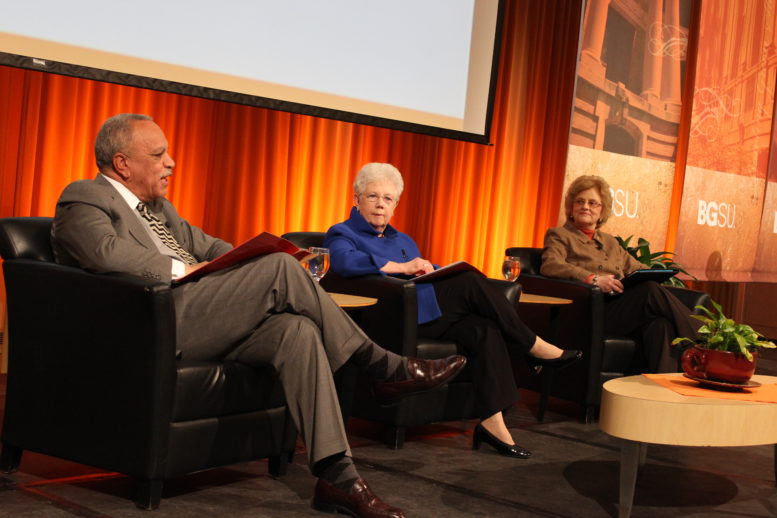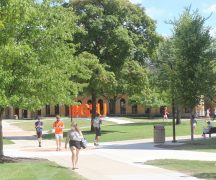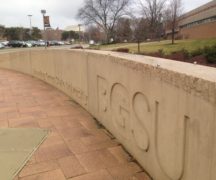By DAVID DUPONT
BG Independent News
The recent history of Bowling Green State University was gathered on stage of the Bowen Thompson Student Union Monday afternoon.
Two past presidents, Sidney Ribeau, 1995-2008, and Carol Cartwright, 2008-2011, and Mary Ellen Mazey, who has been president since 2011, discussed past achievements and the challenges facing the university.
Ribeau said that educators, whether those on the stage with him or the faculty and administrators in the audience, need to advocate for the value of higher education.
“The criticism higher education is taking, that we need to change this way and that way and be more like Fortune 500 companies, is not well founded,” he said. “Higher education in America is still the envy of all the world. … When you travel to other countries, they are modeling their universities after our universities.”
He noted that during the economic downtown when so many sectors of the economy were suffering a meltdown, higher education continued to do well. He dismissed those who say colleges need to graduate students faster and need to make radical changes. “We need to graduate students who want jobs. They need to be able to think, to be able to analyze. They need to have character. They need to stand for something. They need to be leaders so we don’t have the fiasco like we’re seeing in our current presidential campaign.
“Higher education has real role to play in our society,” Ribeau continued. “We need to speak to the value of higher education as a difference maker in our society. We’re not going to have a better world unless we really do things to make it better. And where can we do that? In the laboratory that is our classroom. We need to create a pipeline of thoughtful enlightened individuals. … That’s our challenge.”
In talking about their accomplishments, the presidents spoke on how their work addressed the issues of their time and built on what their predecessors had done. “No president does these things by himself or herself,” Cartwright said. They are built across administrations with the assistance of faculty, staff, administrators and students.
Ribeau launched the university’s first comprehensive campaign that raised $150 million and that concluded during Cartwright’s tenure. Now under Mazey, a second campaign is underway and by the end of its second year she expects it to have raised $80 million. A final goal has yet to be announced.
Under Ribeau, the Student Union was renovated, and the plans for the Wolfe Center for the Arts and the Stroh Center were developed. Cartwright shepherded those projects forward. She found herself campaigning, including visiting dorms in the evenings, to get student approval to tap student fees to help fund the construction of the Stroh Center. She also realized that residence halls needed to be upgraded, in part to fit in with many of the initiatives including learning communities envisioned by Ribeau. In order to facilitate the construction, the university created a separate legal entity, Centennial Falcon Properties, that built two new residence halls with 1,300 new beds and two new dining facilities.
Mazey said in her first year she attended six ribbon cuttings for those facilities as well as the Stroh Center and the Wolfe Center.
Under her tenure, Mazey has sought out partnerships with outside entities to build the new Bowling Green Flight Center, the Falcon Health Center and the state Bureau of Criminal Investigation lab on campus. The latter has resulted in the development of new programs in forensic science.
Mazey has had to contend with both a reduction in state funding as well as the way that funding is distributed. Now universities are awarded for the number of students who graduate.
Mazey said she was proud that incoming freshman classes have been the most academically prepared and diverse, and they are staying at BGSU in record numbers.
Cartwright said during her tenure the state told public universities to study what their “centers of excellence” were. “We took it … as an opportunity for us to really think about academic quality, to think about the strengths of our academic array of programs, and to do it in a way that built clusters of excellence because we believe the world doesn’t solve its problems in single disciplines.”
Cartwright said: “There was an implicit sense underneath this all from state government that there wasn’t that much excellence in Ohio, and we were out to prove them wrong.”
Those five centers of excellence still guide the university, she said. They are: 21st Century educator preparation; the arts; sustainability and the environment; developing effective businesses and organizations; and health and wellness across the lifespan.
Once & future Falcons: BGSU presidents discuss achievements & challenges facing higher ed





